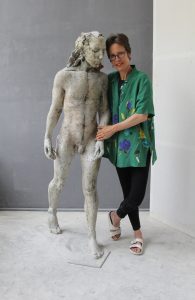 Bärbel Dieckmann, born 1961 in Bielefeld, studied sculpture at the Bielefeld University of Applied Sciences from 1981 to 1988 under Richard Heß, whose assistant she was from 1988 to 1991. From 1991 to 1994 she taught at the master school for craftsmen (stonemasons and stone sculptors department) in Kaiserslautern. Member of the Darmstadt Secession since 1994. Among other awards, she has been presented with the Gustav Weidanz Prize for Sculpture. She has lived as an artist and teacher in Berlin since 1994 and has created many works for the public, e.g. the official portrait of the Federal President Joachim Gauck.
Bärbel Dieckmann, born 1961 in Bielefeld, studied sculpture at the Bielefeld University of Applied Sciences from 1981 to 1988 under Richard Heß, whose assistant she was from 1988 to 1991. From 1991 to 1994 she taught at the master school for craftsmen (stonemasons and stone sculptors department) in Kaiserslautern. Member of the Darmstadt Secession since 1994. Among other awards, she has been presented with the Gustav Weidanz Prize for Sculpture. She has lived as an artist and teacher in Berlin since 1994 and has created many works for the public, e.g. the official portrait of the Federal President Joachim Gauck.
The starting point and central theme of Bärbel Dieckmann’s artistic work is the human figure. Within this basic theme, her spectrum of content is broad: It ranges from direct portraits of specific people to numerous nameless standing, sitting, squatting or reclining figures to the depiction of figures and scenes from (Greek-antique) mythology.
The latter fascinate Dieckmann as embodiments of timeless, current psychological patterns, whereby she is particularly interested in the figure of the Minotaur, the monster combining human and bull features, who was imprisoned in the labyrinth of Knossos and finally killed by Theseus. In addition to many individual depictions of this creature – including even a Minotauria ! – Dieckmann dealt with the myth of Theseus, not least in the context of one of her main sculptural works, the portal to the myth of Theseus, created in 1989.
With a figure construction that is in principle typical of classical ideals 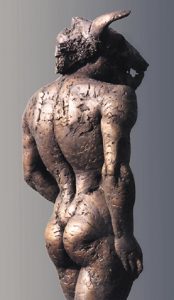 – determined by a proportionally harmonious distribution of masses and volumes – the artist devotes particular attention to the design of the surfaces of her works. While these were never really smooth and closed from the very beginning, their agitation, roughness and fragility increasingly became a characteristic of Dieckmann’s works over the years. The vividly moving surface textures already created in the clay model are further processed after casting until they finally oscillate between sensual beauty and decadent morbidity.
– determined by a proportionally harmonious distribution of masses and volumes – the artist devotes particular attention to the design of the surfaces of her works. While these were never really smooth and closed from the very beginning, their agitation, roughness and fragility increasingly became a characteristic of Dieckmann’s works over the years. The vividly moving surface textures already created in the clay model are further processed after casting until they finally oscillate between sensual beauty and decadent morbidity.
In addition, at the end of the 1990s, the closed forms of Dieckmann’s sculptures were broken up: they were torn open so radically that the view into the hollow interior of the figures was revealed. At the same time, in 1999, sculptural collages were created for the first time, assembling fragmented cast parts into something new that no longer attempted to conceal its disparate nature. In this way, Dieckmann uses roughness and fragility as expressions and metaphors of fleetingness, transience and vulnerability – with a simultaneous reference to the sensual beauty of the broken and morbid – to an openness that reflects the situation of contemporary perception and thought in the awareness of the impossibility of a closed view of man and the world.
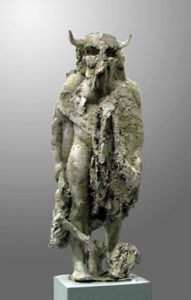 Apart from the formative influence of her teacher Richard Hess and his teacher Waldemar Grzimek – both of whom were decisive for her orientation towards a classicist conception of the figure – Dieckmann received significant influences through the study of works of classical sculpture, but also from representatives of classical modernism such as Auguste Rodin, Aristide Maillol, Wilhelm Lehmbruck, Medardo Rosso, Arturo Martini, Emilio Greco, Marino Marini, Luciano Minguzzi and Pericle Fazzini, Alberto Giacometti, Germaine Richier, Pablo Picasso (whose bullfighting theme played a significant role in inspiring her preoccupation with the Minotaur) and Amadeo Modigliani.
Apart from the formative influence of her teacher Richard Hess and his teacher Waldemar Grzimek – both of whom were decisive for her orientation towards a classicist conception of the figure – Dieckmann received significant influences through the study of works of classical sculpture, but also from representatives of classical modernism such as Auguste Rodin, Aristide Maillol, Wilhelm Lehmbruck, Medardo Rosso, Arturo Martini, Emilio Greco, Marino Marini, Luciano Minguzzi and Pericle Fazzini, Alberto Giacometti, Germaine Richier, Pablo Picasso (whose bullfighting theme played a significant role in inspiring her preoccupation with the Minotaur) and Amadeo Modigliani.
Bärbel Dieckmann works in plaster, terracotta, bronze, stone and concrete. 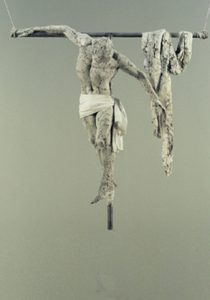 Since 2021, she has also discovered the computer as a tool. Interested in technical innovations since childhood – she also studied physics for 2 semesters – she taught herself to design sculptures in the zbrush program. She then has them printed out on an Internet platform. Nevertheless, working in the analog world remains of essential importance to her, as it offers the possibility of sensory perception not only through the eyes, but also through the sense of touch and thus a direct experience of reality and existence.
Since 2021, she has also discovered the computer as a tool. Interested in technical innovations since childhood – she also studied physics for 2 semesters – she taught herself to design sculptures in the zbrush program. She then has them printed out on an Internet platform. Nevertheless, working in the analog world remains of essential importance to her, as it offers the possibility of sensory perception not only through the eyes, but also through the sense of touch and thus a direct experience of reality and existence.
She would also like to pass on this experience. Dieckmann is a passionate teacher and has created mythological sculptures with both adults and children in order to convey a feeling for the roots of our culture.
Eva Badura-Triska, art historian, curator at MUMOK Vienna from 1978 to 2019
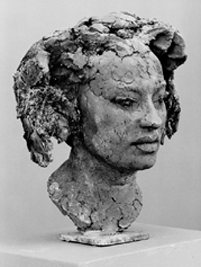 |
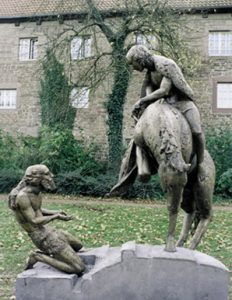 |
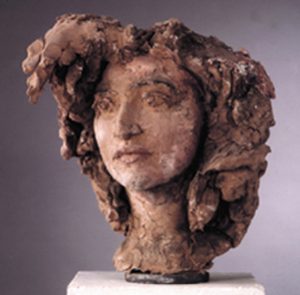 |
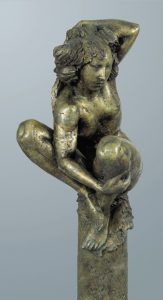 |